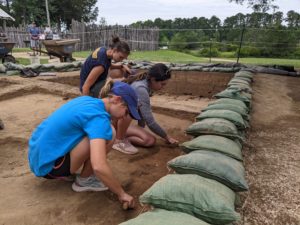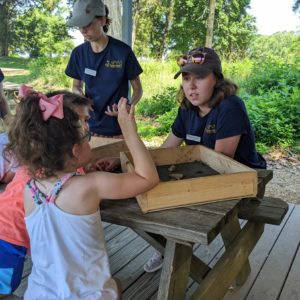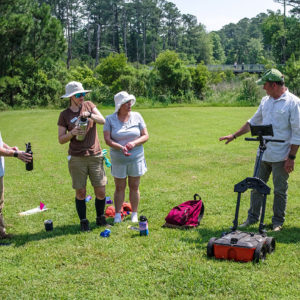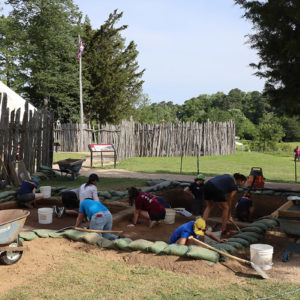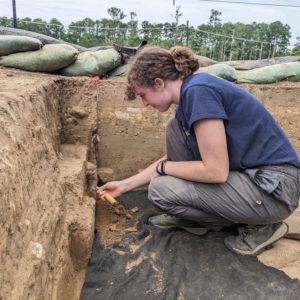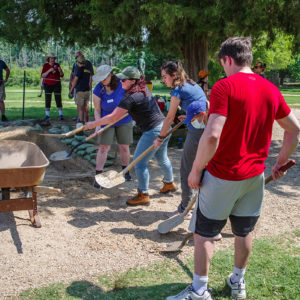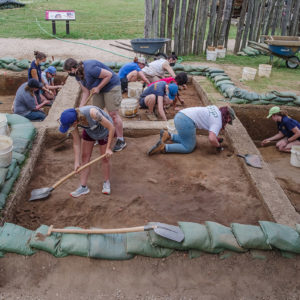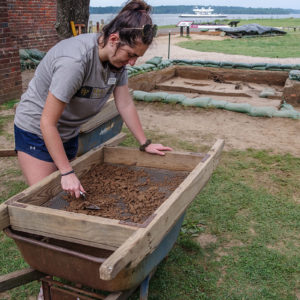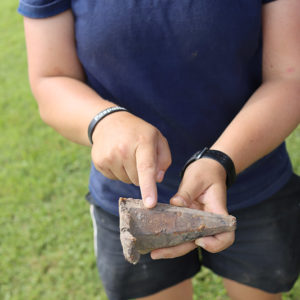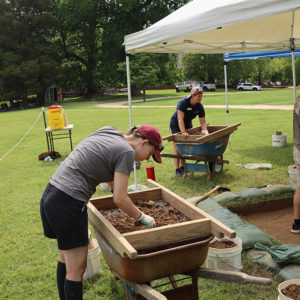The site is bustling with archaeological activity as our team has more than doubled with the addition of 16 students from this year’s archaeological Field School. This Field School — the first since 2017 — started May 31 and is a collaboration between Jamestown Rediscovery and the University of Virginia. Upon completion of the program students will earn six graduate credits from U.Va. and will have learned real-world techniques crucial to conducting field archaeology, including surveying, the use of ground penetrating radar (GPR), excavation, and processing their finds in the lab. The crew has been split into two groups, one of which is excavating just north of the Church Tower while the other is excavating in the field north of the north bulwark, close to a branch of the Pitch and Tar Swamp. Field School students are also working in the conservation lab as part of their studies, learning to sort, clean, and conserve artifacts found in the field. We are also excited about the opening of the Ed Shed, where young visitors can get hands-on experience with real artifacts and learn the archaeological techniques used to identify, date, and give context to finds.
The walking path separating the two archaeological units in the north Church Tower area has been diverted just a few feet to the north so that the area between the existing units can be excavated as well, allowing the team to follow features found in the neighboring units and complete the archaeological map. With the help of the Field School students the archaeologists are making short work of the top layers, primarily consisting of 20th- and 21st-century gravel and landscaping fill. A GPR survey conducted on the western new unit indicated the presence of a large circular feature approximately 7 feet in diameter a few feet beneath the surface. Excavations in the weeks ahead will reveal the nature of this feature. So far a few nails, a porcelain rim sherd, and a few other small artifacts have been found in the new units here.
Just outside of the fort’s north bulwark, excavations have started in an area close to a branch of the Pitch and Tar Swamp. This area yielded some promising hits during GPR surveys several weeks ago and the Field School students used GPR to confirm the presence of an underground feature prior to the start of the excavations. This area of Jamestown is largely unexcavated and the two new units will hopefully give insight into the stratigraphy and features here just outside the fort. The swamp continues to expand in this area due to sea level rise and there is some urgency in the efforts to survey and excavate the area before it too is inundated. Although the excavations just started, some artifacts have already been found including a type of pin maul (a stone mason’s tool), not being produced before the nineteenth century. A fire once burned here, as the southern square contains a large amount of ash mixed in with the soil. Machine-cut nails have been found in abundance here, as well as a sherd of a locally-made pipe bowl.
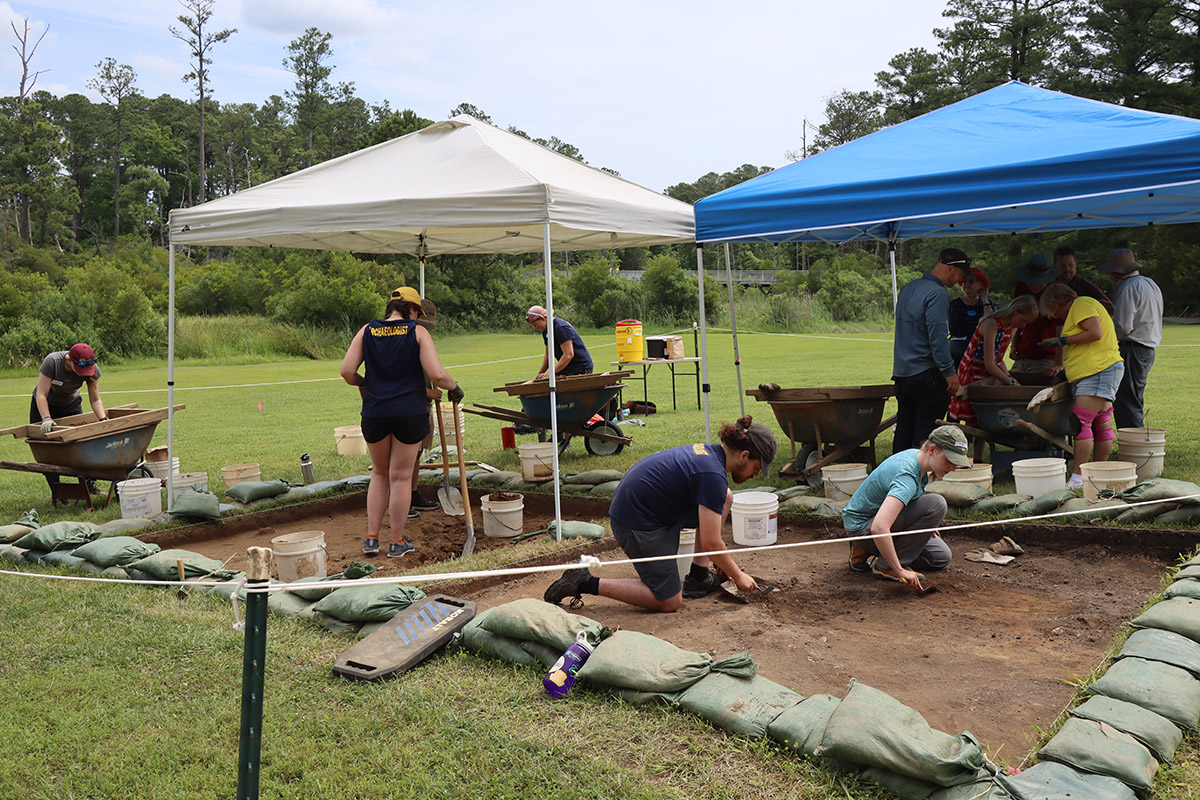
In the Rediscovery Center lab, the Field School students have been sorting through artifacts found in the fort’s first well. Besides giving them a respite from the heat, this lab time will teach them how to sort, clean, conserve, and catalog artifacts once they’re brought in from the dig site. The first well, built in 1608 or 1609, was a treasure trove of artifacts as wells were used as trash pits once their water became foul. Because it was sealed before 1611, this well gives us a glimpse into an unusually well-defined moment in time which included the Starving Time winter of 1609-1610, evidenced by thousands of bones of animals not normally eaten by the English. The experience of processing these artifacts will teach valuable lessons in artifact processing and the struggles these early colonists faced when food was almost non-existent and trips outside the fort’s walls for food were met by ambushes at the hands of Virginia Indians.
The Ed Shed is open for the season! The Ed Shed gives young visitors the ability to learn archaeological techniques using real artifacts found just feet away. Sorting through artifacts of Virginian and European origin including pottery, animal bones, projectile points and more, visitors will learn what and how archaeologists learn from these objects. An Ed Shed visitor just found a mussel shell bead while sorting through material from the first well. Also at the Ed Shed is a Geographical Information System (GIS) workstation where visitors can draw archaeological features on a map of Jamestown precisely where they were found and compare them with hundreds of other features already on the map. The Ed Shed is open through August 6, Tuesday – Saturday, 9:00am – 4:30pm.
related images
- Director of Archaeology David Givens teaches Field School students how to use the GPR.
- The north Church Tower excavations
- Archaeologist Brenna Fennessey digging at the north Church Tower site.
- The Field School students begin excavating one of the new units north of the Church Tower.
- The north Church Tower excavations
- Screening soil at the north Church Tower excavations
- The excavations north of the fort
- Archaeologist Caitlin Delmas holds the pin maul found in the excavations north of the fort.
- Screening soil from the excavations north of the fort
- The nails and pipe bowl fragment from the excavations just north of the fort



